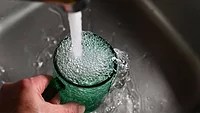EPA Finalizes National Drinking Water Standard for PFAS; Will Fund $1B in Testing, Remediation

Image credit: Anderson Rian via Unsplash
On April 10, 2024, the U.S. Environmental Protection Agency (EPA) issued the first-ever national, legally enforceable drinking water standard to protect Americans from exposure to harmful per-and polyfluoroalkyl substances (PFAS), also known as “forever chemicals” due to their inability to break down over time and their accumulation in the human body and the environment. EPA has also announced $1 billion in funds available for PFAS testing and clean-up in state, territory, and private drinking water supplies.
Just ahead of the recent announcement, on April 9, EPA also released an updated guidance for industry on destroying and disposing of PFAS.
Exposure to PFAS has been linked to cancer, impacts to the liver and heart, and immune and developmental damage to infants and children. EPA estimates that the new standard will reduce PFAS exposure for approximately 100 million people, prevent thousands of deaths, and reduce tens of thousands of serious illnesses.
The new final rule sets legally enforceable levels for five PFAS known to occur individually and as mixtures in drinking water: PFOA, PFOS, PFNA, PFHxS, and HFPO-DA (also known as GenX Chemicals). The rule also sets a limit for mixtures of any two or more of four PFAS: PFNA, PFHxS, PFBS, and GenX chemicals. Details about the final PFAS drinking water standards include:
- For PFOA and PFOS, EPA is setting a Maximum Contaminant Level Goal, a non-enforceable health-based goal, at zero. This reflects the latest science showing that there is no level of exposure to these contaminants without risk of health impacts, including certain cancers.
- EPA is setting enforceable Maximum Contaminant Levels at 4.0 parts per trillion for PFOA and PFOS, individually. This standard will reduce exposure from these PFAS in our drinking water to the lowest levels that are feasible for effective implementation.
- For PFNA, PFHxS, and GenX Chemicals, EPA is setting the MCLGs and MCLs at 10 parts per trillion.
- Because PFAS can often be found together in mixtures, and research shows these mixtures may have combined health impacts, EPA is also setting a limit for any mixture of two or more of PFNA, PFHxS, PFBS, and GenX Chemicals.
EPA is issuing this rule after reviewing extensive research and science on how PFAS affects public health, while engaging with the water sector and with state regulators to ensure effective implementation. EPA also considered 120,000 comments on the proposed rule from a wide variety of stakeholders.
EPA estimates that between about 6 and 10 percent of the 66,000 public drinking water systems subject to the rule may have to take action to reduce PFAS to meet these new standards. All public water systems have three years to complete their initial monitoring for these chemicals. They must inform the public of the level of PFAS measured in their drinking water. Where PFAS is found at levels that exceed these standards, systems must implement solutions to reduce PFAS in their drinking water within five years.
The final rule represents the most significant step to protect public health under EPA’s PFAS Strategic Roadmap. The announcement also complements President Biden’s government-wide action plan to combat PFAS pollution.
Through President Biden’s Investing in America agenda, EPA is making available $1 billion in funding through the Bipartisan Infrastructure Law to help states and territories implement PFAS testing and treatment at public water systems, and to help owners of private wells address PFAS contamination. This is part of a $9 billion investment through the Bipartisan Infrastructure Law to help communities with drinking water impacted by PFAS and other emerging contaminants—the largest-ever investment in tackling PFAS pollution. An additional $12 billion is available through the Bipartisan Infrastructure Law for general drinking water improvements, including addressing emerging contaminants like PFAS.
Looking for quick answers on food safety topics?
Try Ask FSM, our new smart AI search tool.
Ask FSM →
EPA Administrator Michael Regan will join White House Council on Environmental Quality Chair Brenda Mallory to announce the final standard on April 10 at an event in Fayetteville, North Carolina. In 2017, area residents learned that the Cape Fear River, the drinking water source for 1 million people in the region, had been heavily contaminated with PFAS pollution from a nearby manufacturing facility.
The new limits in this rule are achievable using a range of available technologies and approaches including granular activated carbon, reverse osmosis, and ion exchange systems. For example, the Cape Fear Public Utility Authority has effectively deployed a granular activated carbon system to remove PFAS regulated by the new rule. Drinking water systems will have flexibility to determine the best solution for their community.
In the coming weeks, EPA will host a series of webinars to provide information to the public, communities, and water utilities about the final PFAS drinking water regulation. More information about the webinars can be found on EPA’s PFAS drinking water regulation webpage. EPA has also published a toolkit of communications resources to help drinking water systems and community leaders educate the public about PFAS, where they come from, their health risks, how to reduce exposure, and about this rule.
Additionally, EPA has a nationwide Water Technical Assistance program to help small, rural, and disadvantaged communities access federal resources by working directly with water systems to identify challenges like PFAS; develop plans; build technical, managerial, and financial capacity; and apply for water infrastructure funding.









